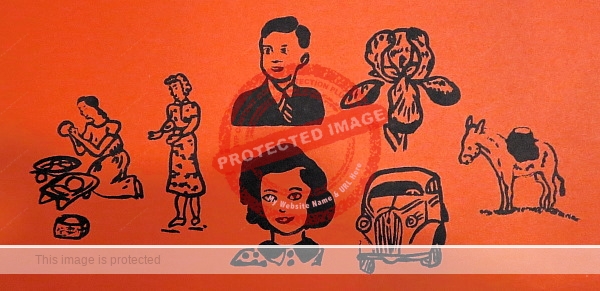Distinguished American poet and painter John Brandi (born in California in 1943) and his wife Gioia lived in Jocotepec for about eighteen months, from the winter of 1968-69 to mid-1970. The couple’s youngest child, Giovanna, was born in Jocotepec.
Brandi graduated in 1965 from California State University, Northridge, with a B.A. in art and anthropology, before working as a Peace Corps volunteer with Andean farmers in Ecuador from 1966 to 1968. In Ecuador, he began to keep detailed, illustrated journals, a practice he continued while in Mexico. He was an early proponent of “do-it-yourself” self-publishing, producing hand-sewn mimeograph editions.
During his time in Jocotepec, Brandi composed illustrated “myth masses”, as well as hand-made poetry books.
In April 1969, Brandi took part in a collective exhibit that opened 18 April 1969 at La Galería, Ajijic. The announcement in Guadalajara daily Informador (20 April) lists the artists as John Kenneth Peterson, Charles Henry Blodgett (guest artist) and “El Grupo” (John Brandi, Tom Brudenell, Peter Paul Huf, his wife Eunice (Hunt) Huf, Jack Rutherford, Shaw, Cynthia Siddons and Robert Snodgrass).
In June 1969, and in a bid to challenge the artistic status quo in the Lake Chapala area, John Brandi joined with Brudenell and Shaw (all three artists were living in Jocotepec) in staging the Chula Vista “happening”. Brandi contributed drawings, milagros (folk charms) and poems to the happening, which opened, perhaps appropriately, on Friday 13 June.
Brandi, a life-long political activist who joined protests against the American War in Vietnam, was living in the San Francisco Bay area, when he found his first publishing success, with a collection of poems entitled Desde Alla (Christopher’s Press, 1971). While he was living for a summer in a miner’s shack in the Sierra Nevada foothills of California, he met Gary Snyder, immortalized by Jack Kerouac in The Dharma Bums as Japhy Ryder. Snyder introduced him to Japanese poet-wanderer Nanao Sakaki.
In 1971, Brandi moved to New Mexico, where he built a cabin in a remote canyon, and founded Tooth of Time Books, which became a nationally-recognized poetry press.
John Brandi has had numerous collections of his poetry published, including Desde Alla (Christopher’s Press, 1971); Chimborazo: Life on the Haciendas of Ecuador (Akwesasne Notes Press, 1976); That Back Road In (Wingbow Press, 1985); Shadow Play: poems 1987-1991 (Light and Dust Books, 1992); Weeding the Cosmos (La Alameda Press, 1994); Heartbeat Geography: Selected & Uncollected Poems (White Pine Press, 1995); A Question of Journey: travel episodes India, Nepal, Thailand (Book Faith, India, 1999); Reflections in the Lizard’s Eye: High Desert Notes (Western Edge Press, 2000); Empty Moon : Belly Full, Haiku from India & Nepal (Pilgrims Publishing, India, 2000); In What Disappears (White Pine Press, 2003); One Cup and Another (Tangram Press, 2004); Water Shining Beyond the Fields (Tres Chicas Press, 2005); Staff in Hand, Wind in Pines (Tangram Press, 2008); Facing High Water (White Pine Press, 2008); Road to the Cloud’s House (with Renée Gregorio, La Alameda Press, 2009); Seeding the Cosmos: New & Selected Haiku (La Alameda Press, 2010); and The World, the World (White Pine Press, 2013).
Brandi has also undertaken translations, including parts of An Eye through the Wall: Mexican Poetry, 1970-1985 (Tooth of Time Books, 1986).
Brandi’s paintings have featured in numerous exhibitions including: San Francisco Public Library; Roswell Museum of Art, Roswell; New Mexico History Museum, Palace of the Governors, Santa Fe; Loka Cafe Gallery, Taos; Harwood Art Center, Albuquerque; Cruz Gallery, Santa Fe; Randall Davey Audubon Center, Santa Fe; Claudia Chapline Gallery, Stinson Beach, California; North Columbia Cultural Center, Nevada City, California; Woodland-Pattern Book Center, Milwaukee; Laurel Seth Gallery, Santa Fe; University of New Mexico Thompson Gallery, Albuquerque; Return Gallery, Taos; Moody Gallery, Houston, Texas.
Source
http://www.johnbrandi.com/art-oils-acrylics.html [14 May 2015]
Sombrero Books welcomes comments, corrections or additional material related to any of the writers and artists featured in our series of mini-bios. Please use the comments feature at the bottom of individual posts, or email us.
Tony Burton’s books include “Lake Chapala: A Postcard History” (2022), “Foreign Footprints in Ajijic” (2022), “If Walls Could Talk: Chapala’s historic buildings and their former occupants” (2020), (available in translation as “Si Las Paredes Hablaran”), “Mexican Kaleidoscope” (2016), and “Lake Chapala Through the Ages” (2008).
